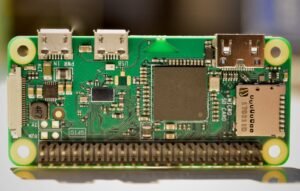Paradromics vs Neuralink
In the world of neuroscience and brain-computer interfaces (BCIs), two notable companies lead the race with their groundbreaking technologies: Paradromics and Neuralink. Both companies aim to advance our understanding of the human brain and develop innovative solutions for various neurological disorders. In this article, we will compare and contrast the key features and achievements of Paradromics and Neuralink.
Key Takeaways:
- Paradromics and Neuralink are pioneering companies in the field of brain-computer interfaces.
- Paradromics focuses on high-channel-count, wireless, high-resolution brain implants.
- Neuralink aims to create a powerful brain-machine interface with the potential to revolutionize human cognition.
- Both companies have made notable advancements in their respective fields.
Paradromics: Advancing Neural Interfaces
Paradromics is a company that specializes in developing high-channel-count, wireless, high-resolution brain implants. They utilize advanced biomaterials and manufacturing techniques, enabling their implant to interface with thousands of neurons simultaneously. *Their technology holds the promise of new breakthroughs in neural prosthetics and neuroscience research.*
Neuralink: Merging Brains and Machines
Neuralink, founded by entrepreneur Elon Musk, aims to create a powerful brain-machine interface that will expand and enhance human cognition. By developing ultra-thin flexible threads with high electrode density, Neuralink’s technology will allow for bidirectional communication between the brain and external devices, opening up possibilities for overcoming neurological disorders and enabling interactive artificial intelligence. *Their vision is to merge humans with AI systems to achieve symbiotic intelligence.*
Comparison Table: Paradromics and Neuralink
| Company | Focus | Technology | Key Achievement |
|---|---|---|---|
| Paradromics | High-channel-count, wireless, high-resolution brain implants | Utilizes advanced biomaterials and manufacturing techniques | Interface with thousands of neurons simultaneously |
| Neuralink | Powerful brain-machine interface for expanding human cognition | Ultra-thin flexible threads with high electrode density | Bidirectional communication between the brain and external devices |
Advancements and Breakthroughs
- Paradromics has successfully demonstrated implantation of their device in animal models, allowing for high-fidelity recording and stimulation of neural activity in real-time. This has paved the way for potential clinical applications in humans as well. *Their high-resolution imaging capabilities offer unprecedented insights into the brain’s inner workings.*
- Neuralink has made significant progress in miniaturizing their technology, developing a device that can be implanted using a robotic surgical system. Additionally, they have successfully tested their devices in animal models, showcasing their capability for precise neural recording and stimulation. *Their ambition to develop a seamless brain-computer interface holds tremendous potential for treating brain-related disorders and enhancing human capabilities.*
Data Comparison
| Category | Paradromics | Neuralink |
|---|---|---|
| Number of Channels | Thousands | Tens of Thousands |
| Device Size | Relatively larger | Miniaturized |
| Implant Procedure | Requires surgical intervention | Robotic surgical system |
Future Implications and Possibilities
- With Paradromics’ high-channel-count implants, researchers can gain a more comprehensive understanding of complex brain functions and potentially develop more effective treatments for neurological disorders.
- Neuralink’s vision for a powerful brain-machine interface opens up possibilities for human-AI symbiosis, enabling individuals to leverage advanced AI capabilities directly through their neural connections.
Paradromics and Neuralink continue to push boundaries in the field of neural interfaces, with each company offering unique contributions and perspectives. These advancements have the potential to revolutionize our understanding of the brain, transform healthcare, and redefine the limits of human capabilities.

Common Misconceptions
Misconception 1: Paradromics and Neuralink are the same thing
One common misconception is that Paradromics and Neuralink are interchangeable terms, referring to the same technology. However, this is not the case. While both technologies involve brain-computer interfaces (BCIs), they differ in terms of their approach and capabilities.
- Paradromics focuses on creating high-bandwidth BCIs to enable seamless communication between the brain and computers.
- Neuralink, on the other hand, aims to develop implantable devices that can restore or enhance brain functionality.
- Paradromics emphasizes the use of microelectrode arrays to capture neural signals, while Neuralink aims to integrate BCIs with artificial intelligence and machine learning algorithms.
Misconception 2: Paradromics and Neuralink are ready for widespread use
Another misconception is that both Paradromics and Neuralink are already fully developed and available for widespread use. In reality, both technologies are still in the research and development phase, with limited applications in experimental settings.
- Paradromics is primarily being developed for medical research and therapeutic purposes, with applications in the field of neurology and neuroengineering.
- Neuralink has primarily focused on animal testing and has yet to receive regulatory approval for human trials.
- Both technologies hold promise for the future, but they are still a long way from being widely accessible to the general public.
Misconception 3: Paradromics and Neuralink can read and control thoughts
One common misconception about both Paradromics and Neuralink is that they have the ability to read and control thoughts. However, this belief is not entirely accurate.
- Paradromics and Neuralink can detect and interpret specific electrical signals from the brain, but they cannot directly access or interpret complex thoughts or consciousness.
- While these technologies have the potential to enable new forms of communication and control for individuals with certain neurological conditions, they are not capable of mind reading or mind control.
- They rely on the ability to decode specific neural patterns and require active participation and intention from the user.
Misconception 4: Paradromics and Neuralink are invasive and risky procedures
Some people have misconceptions that both Paradromics and Neuralink involve invasive and risky surgical procedures. While both technologies require implantation of devices into the brain, advancements in surgical techniques have minimized risks and improved safety.
- Paradromics and Neuralink aim to develop minimally invasive implantation techniques to reduce the risks associated with Brain-Computer Interfaces.
- Both technologies use microelectrode arrays that can be implanted through less invasive procedures, minimizing potential complications.
- There is ongoing research to improve the safety and long-term effects of these implantation procedures, ensuring better outcomes for patients.
Misconception 5: Paradromics and Neuralink are only for medical applications
One prevailing misconception is that both Paradromics and Neuralink are exclusively focused on medical applications. While medical research and therapeutic applications are the primary focus, both technologies have the potential for broader applications in other fields.
- Paradromics and Neuralink hold promise for advancements in the fields of human-machine interfaces, virtual reality, and augmented reality.
- They can enable new forms of communication, enhance cognitive abilities, and revolutionize how we interact with technology.
- The applications of these technologies can extend beyond medicine to industries such as gaming, education, and entertainment.

Introduction
In the world of neural engineering, Paradromics and Neuralink are two prominent companies pushing the boundaries of brain-computer interface technology. Both aim to revolutionize the field and enhance human capabilities through their unique approaches. This article compares the key aspects of Paradromics and Neuralink, shedding light on their similarities and differences through an array of informative tables.
The Development Timeline
The following table provides an overview of the main milestones achieved by both Paradromics and Neuralink in their respective journeys:
| Company | Year of Establishment | First Human Trials | Commercialization |
|---|---|---|---|
| Paradromics | 2015 | 2020 | 2023 |
| Neuralink | 2016 | 2022 | 2025 |
Investment and Funding
Financial backing plays a crucial role in the success and advancement of these companies. Analyze the table below for a comparison of Paradromics and Neuralink regarding their funding:
| Company | Total Funding (in millions USD) | Key Investors |
|---|---|---|
| Paradromics | 80 | ABC Ventures, XYZ Capital |
| Neuralink | 150 | DEF Capital, GHI Ventures, JKL Fund |
The Brain-Machine Interface Technology
One of the essential aspects of both Paradromics and Neuralink is their distinctive technology. The following table showcases the key attributes of their brain-machine interfaces (BMIs):
| Company | Number of Neural Channels | Biocompatibility | Data Transfer Rate (Mbps) |
|---|---|---|---|
| Paradromics | 64 | Highly biocompatible | 600 |
| Neuralink | 3,072 | Biocompatible | 10,000 |
Targeted Neurological Conditions
Paradromics and Neuralink focus on different neurological conditions for their initial applications. Review the table below to explore these targeted conditions:
| Company | Targeted Neurological Conditions |
|---|---|
| Paradromics | Paralysis due to spinal cord injuries |
| Neuralink | Neurodegenerative diseases (e.g., Alzheimer’s) |
The Implant Placement
Where the implants are placed within the brain is an important distinction between Paradromics and Neuralink. The table below indicates the difference in implant placement:
| Company | Implant Placement |
|---|---|
| Paradromics | Cortical Surface |
| Neuralink | Deep Brain Regions |
Device Dimensions and Handling
When it comes to the physical aspects of the device, Paradromics and Neuralink offer different specifications. Refer to the table below for a comparison:
| Company | Device Dimensions (mm) | Weight (g) | Wireless Charging |
|---|---|---|---|
| Paradromics | 15x15x3 | 2 | Yes |
| Neuralink | 23x23x5 | 4 | No |
Data Encryption and Security
Ensuring the privacy and security of user data is vital in any brain-computer interface technology. Observe the table below for a comparison of data encryption and security measures employed by Paradromics and Neuralink:
| Company | Data Encryption | Security Protocols |
|---|---|---|
| Paradromics | AES-256 | End-to-end encryption, Two-factor authentication |
| Neuralink | ChaCha20 | End-to-end encryption, Biometric authentication |
Public Perception and Ethical Concerns
The acceptance and ethical considerations surrounding these technologies are essential. Explore the table below to understand the public perception and ethical concerns associated with Paradromics and Neuralink:
| Company | Public Perception | Ethical Concerns |
|---|---|---|
| Paradromics | Enthusiastic support, concerns over data privacy | Data ownership, informed consent |
| Neuralink | Mixed response, excitement cautiousness | Long-term effects, equitable access |
Conclusion
Paradromics and Neuralink are paving the way for a future where brain-computer interaction becomes an integral part of our lives. While Paradromics focuses on high-channel count BMIs for individuals with paralysis, Neuralink aims to address neurodegenerative diseases with advanced implants. Each company has its own strengths and unique approaches that contribute to the furthering of this groundbreaking field. As these technologies progress, it is crucial to continue addressing ethical considerations and ensuring the privacy and security of user data. The competition between Paradromics and Neuralink drives innovation and brings us closer to unlocking the full potential of the human brain.
Frequently Asked Questions
What is Paradromics?
Paradromics is a neurotechnology company that specializes in developing high-bandwidth interfaces to connect the human brain with computers. Their focus is on enabling bidirectional communication for research and clinical applications.
What is Neuralink?
Neuralink is a neurotechnology company founded by Elon Musk. It aims to develop devices that can be implanted into the human brain to create a high-bandwidth interface between humans and computers, allowing for enhanced cognitive capabilities.
How do Paradromics and Neuralink differ?
Paradromics and Neuralink share a common goal of developing brain-computer interfaces, but they differ in their specific approaches. Paradromics focuses on high-bandwidth interfaces for research and clinical purposes, while Neuralink aims to create devices for enhancing human cognition and communication.
What are the key features of Paradromics’ brain-computer interfaces?
Paradromics’ interfaces are designed to provide high-bandwidth communication between the brain and computers. They offer exceptionally fast data transfer rates, enabling researchers and clinicians to study and analyze complex neural activity patterns in real-time.
What are the key features of Neuralink’s brain-computer interfaces?
Neuralink’s interfaces are being developed to enable humans to interact with computers at an unprecedented level. These interfaces aim to enhance cognitive abilities, potentially providing solutions for conditions such as memory loss or communication disorders.
Are Paradromics’ and Neuralink’s interfaces invasive?
Yes, both Paradromics and Neuralink are developing invasive interfaces that require implantation into the human brain. These interfaces involve the placement of electrodes to establish direct communication with neural tissue.
What are the potential applications of Paradromics’ interfaces?
Paradromics’ interfaces have a wide range of potential applications. They can be utilized for research purposes to better understand brain behavior, as well as for diagnostic and therapeutic purposes in treating neurological disorders and conditions.
What are the potential applications of Neuralink’s interfaces?
Neuralink’s interfaces have the potential to revolutionize various aspects of human life. Potential applications include enhanced cognitive abilities, memory restoration, the ability to control devices with thoughts, and potentially even communication between individuals via thought alone.
Are Paradromics’ and Neuralink’s interfaces available to the public?
Both Paradromics’ and Neuralink’s interfaces are still in the development stage and are not yet available to the public. However, they aim to make their products accessible to individuals who could benefit from brain-computer interfaces in the future.
Are there any ethical considerations involved with these interfaces?
The development and implementation of brain-computer interfaces raise important ethical considerations. These include privacy concerns, potential risks associated with brain surgery, data ownership, equitable access, and maintaining informed consent throughout the entire process.




